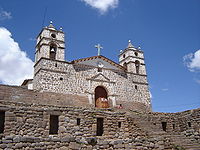Ayacucho
Ayacucho | |
|---|---|
 Ayacucho's cathedral by night | |
| Nickname: City of Churches | |
| Country | Perú |
| Region | Ayacucho |
| Province | Huamanga |
| Settled | April 25, 1540 |
| Government | |
| • Mayor | Germán Martinelli Chuchón |
| Elevation | 2,761 m (9,058 ft) |
| Population (2007)[1] | |
| • Total | 151,019 |
| Time zone | UTC-5 (PET) |
| • Summer (DST) | UTC-5 (PET) |
| Area code | 66 |
| Website | http://www.munihuamanga.gob.pe/ |
Ayacucho (Ayacuchu in Quechua) is the capital city of Huamanga Province, Ayacucho Region, Peru.
Ayacucho is famous for its 33 churches which represent one for every year of Jesus's life.[2]. Ayacucho entertains large religious celebrations especially during Holy Week. These celebrations include horse races featuring Peruvian Caballos de Paso and the traditional running of the bulls, known locally as the jalatoro or pascuatoro. The jalatoro is similar to the Spanish encierro, except that the bulls are led by horses of the Morochucos.
The name is derived from quechua «aya» (death) and «cuchu» (outback). Another derivation, or possibly the original meaning, is "purple soul" as 'aya' (soul) and 'kuchu' (purple).[citation needed]
History
Vestiges of human settlements more than 15,000 years old have been found in the site of Pikimachay, about 25 km north of Ayacucho. In the 6th and 12th centuries, the region became occupied by the Huari Culture, which became the first expansionist empire known in the Andes before the Incas.



The Ayacucho region is the site where Indigenous civilizations settled for thousands of years, incluiding the Wari, Chanka, Nasca and others.
The modern colonial establishment of Ayacucho was led by Spanish invader Francisco Pizarro on April 25, 1540, as San Juan de la Frontera de Huamanga (St. John on the Huamanga Frontier). Due to the constant Incan rebellion led by Manco Inca against the Spanish on the zone, Pizarro was quick to populate it with a small number of Spaniards brought over from Lima and Cusco. On May 17, 1544, by Royal decree Ayacucho received its title of "La Muy Noble y Leal Ciudad de Huamanga". On February 15, 1825, by decree of Simón Bolívar, the city's name was changed to the original "Ayacucho".
The city's main University was founded on July 3, 1677 as the Universidad Nacional San Cristóbal de Huamanga (National University of St. Christopher of Huamanga).
The city is named after the historical Battle of Ayacucho. Upon seeing so many casualties on the battlefield, the settlers named the area Ayakuchu, aya meaning "soul" or "dead" and kuchu meaning "corner" in the Quechua language. The Battle of Ayacucho was the last armed clash between Spanish armies and patriots during the Peruvian War of Independence. The battle developed in the nearby pampa of La Quinua on December 9, 1824. The patriot victory sealed the independence of Peru and South America. La Paz, now capital of Bolivia, was also similarly renamed La Paz de Ayacucho following this battle.
The city's economy is based on agriculture and light manufactures, including textiles, pottery, leather goods, and filigree ware. It is also a regional tourism attraction for its 33 churches built in the colonial period, and for the near battlefield of La Quinua, where the Ayacucho battle was fought in 1824.
In 1980, it was from this city that the Shining Path (Sendero Luminoso) launched its bloody campaign against the government. The campaign faded after the leader Abimael Guzmán Reynoso was captured in 1992, and put in prison. Some followers are active in alliance with narcos for cocaine trafficking; it is not believed that they can grow, though. The region headed by Ayacucho is one of the poorest of the country, yet. However, since peace returned for the last 15 years, the citizenship works hardly to improve. Most of the victims in the final report by the Commission for the Truth and Reconciliation (CVR, 2004) were from Ayacucho region, moslty Quechua Indigenous peoples.
Notable people from Ayacucho
- Andrés Avelino Cáceres, President of Peru (1886-1890) and from (1894-1895)
- Raúl García Zárate, guitarist
- María Parado de Bellido, heroine in War of Independence
- Luis Guillermo Lumbreras, archaeologist
- Juan de Mata Peralta Ramirez, writer
- Alberto Arca Parró, economist and lawyer
- Harry Guillermo Mendoza, prominent urban scientist
- Efraín Morote, anthropologist and university provost.
See also
13°09′47″S 74°13′28″W / 13.16306°S 74.22444°W
References
- ^ Instituto Nacional de Estadística e Informática, Perfil Sociodemográfico del Perú pp. 30.
- ^ Churches of Ayacucho.


